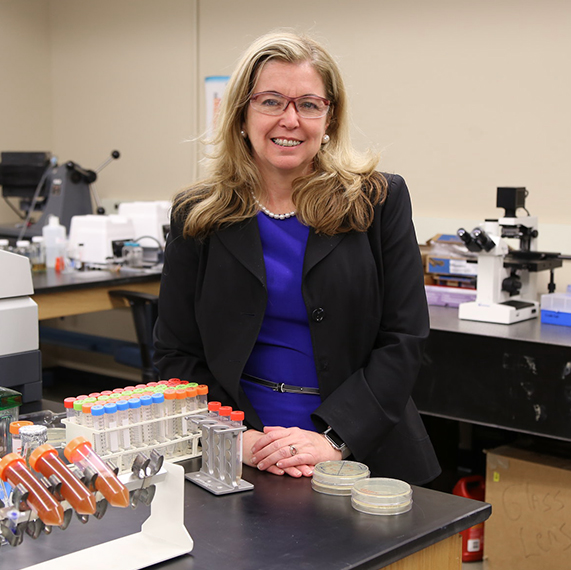Using nanomaterials for big issues in biomed, biotech
Center for Biomedical Engineering Director Vicki Colvin and the Colvin Lab work with materials that do impossible things, exploring how nanoscale particles interact with the environment and living systems.
 With professorships in three departments on campus and a recent appointment to serve as Director of the Center for Biomedical Engineering, Vicki Colvin is a master of working on multiple projects at once. The Vernon K. Krieble Professor of Chemistry and Engineering and Professor of Molecular Pharmacology, Physiology and Biotechnology teaches both undergraduates and graduate students, and leads a research group which is investigating the unique and responsive behavior of nanoparticles to solve problems related to water purification and imaging disease.
With professorships in three departments on campus and a recent appointment to serve as Director of the Center for Biomedical Engineering, Vicki Colvin is a master of working on multiple projects at once. The Vernon K. Krieble Professor of Chemistry and Engineering and Professor of Molecular Pharmacology, Physiology and Biotechnology teaches both undergraduates and graduate students, and leads a research group which is investigating the unique and responsive behavior of nanoparticles to solve problems related to water purification and imaging disease.
One such project is a current in vivo study and paper concerning Magnetic Resonance Imaging (MRI) with nanoscale particles. “The MRI is the most important diagnostic tool for doctors today,” Colvin said. “The problem is that its information can be subtle. It’s like looking through fuzzy gauze.”
Colvin’s idea to get a higher resolution picture involves the nanoparticle gadolinium oxide. “Imagine if you could see specific details of the liver to see how sick a person was, how the illness is developing, at what stage a patient was. That would be the dream of a physician, right? Not just to see it, but to know precisely,” she said. Gadolinium oxide is a new breed of contrast agents; when formed as a nanoparticle it has the potential to detect the early stages of liver disease, where Colvin’s MRI studies have been focused.
These smaller-sized materials are taken up by the cells in the liver, showing a brighter picture of disease progression before the point of scarring and cirrhosis. “This is an example of where the molecular form doesn’t work as well,” Colvin said, taking a teaching moment to illustrate how cellular machinery gobbles up the nanoparticles, keeping them in a more centralized location within a body, as opposed to smaller molecular agents that disperse throughout the body.
“These well-positioned gadolinium agents are brighter, without the high doses, and with much lower toxicity. Clinicians are telling us at least three percent of the population cannot receive gadolinium in its molecular form, so here is an alternative.” Colvin is hopeful this innovative approach does not stop at the liver. She would like to see it applied to the kidney function of the diabetic, as well as to cartilage degradation (arthritis) that is being treated with stem cells.
As a pioneer in the research of global water treatment and the suite of problems that lie therein, Colvin remains one of the nation’s top scientists working on a project she terms the “living filter.” She came to this project after a decades-old interest in extracting arsenic, nitrates and a variety of other toxic contaminants from the drinking water of more than 65 million people at risk from health problems due to water contamination. She is building partnerships with University of Rhode Island engineers to test her materials on the ground in Central and South America, and continues to push the envelope in terms of water purification systems.
“We know we can make materials that can really clean water,” Colvin said. “The issue is whether we can do it at low enough cost and with global distribution. Basically, we have to make amazing treatment materials that are literally cheaper than dirt and globally available to rural and urban communities who need them.”
We are still in engineering mode to figure out the best design for the living system.
This is where she sees a role for biology to augment what can be done with nanoparticles. Her lab creates microbes that are genetically modified to specifically interact with water contaminants. The microbe-nanoparticle assemblies can act “like little magnetic tugboats,” she said – removing the heavy metals in solid state forms.
“We are still in engineering mode to figure out the best design for the living system,” Colvin said. “It may be that we can sweep treated water magnetically to remove the materials, or perhaps we can simply place them in something akin to a tea bag.”
Arsenic removal by the cells is highly selective, and these living sorbents can operate in low pH environments. Colvin’s group has also tested diverse samples like fruit juices and processed wines, with an eye on future industrial uses of this biotechnology.